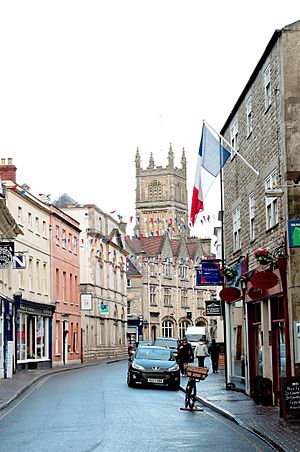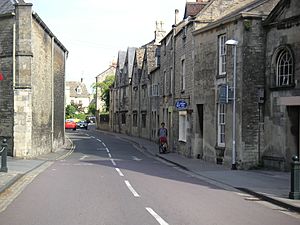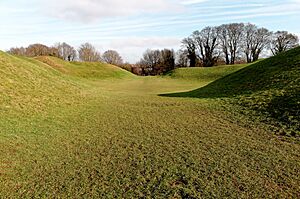Cirencester facts for kids
Quick facts for kids Cirencester |
|
|---|---|
| Market town | |
 |
|
| Population | 20,229 (2021 Census) |
| OS grid reference | SP022021 |
| District |
|
| Shire county | |
| Region | |
| Country | England |
| Sovereign state | United Kingdom |
| Post town | CIRENCESTER |
| Postcode district | GL7 |
| Dialling code | 01285 |
| Police | Gloucestershire |
| Fire | Gloucestershire |
| Ambulance | Great Western |
| EU Parliament | South West England |
| UK Parliament |
|
Cirencester (pronounced like SY-rən-ses-tər) is a lively market town in Gloucestershire, England. It sits on the River Churn, which is a small river that flows into the famous River Thames. Cirencester is the biggest town in the beautiful Cotswolds area and the eighth largest place in Gloucestershire.
The town is home to the Royal Agricultural University, which started in 1840. It's the oldest college for farming studies in the English-speaking world! In 2021, about 20,229 people lived in Cirencester. The town is located about 18 miles (29 km) northwest of Swindon and 18 miles (29 km) southeast of Gloucester.
Long ago, the Romans called this town Corinium. This name might have come from the ancient British tribe called the Dobunni. The earliest mention of the town was in AD 150. If you visit Cirencester, you can see many Roman items at the Corinium Museum.
Cirencester is also "twinned" with a town in Germany called Itzehoe. This means they have a special friendship and often share cultural events.
Contents
Exploring Cirencester's Location
Cirencester is nestled in the lower parts of the Cotswold Hills. These hills are made of a special type of limestone rock. The River Churn flows through the eastern side of the town, heading south to join the River Thames near Cricklade. Interestingly, the River Thames itself starts just a few miles west of Cirencester!
The town is divided into five main areas: the town centre, the village of Stratton, the suburb of Chesterton, Watermoor, and The Beeches. A nearby village called Siddington is now almost connected to Watermoor. Cirencester is an important hub for the villages around it, offering jobs, shops, and schools. Many people also live here and travel to bigger cities like Cheltenham, Gloucester, Swindon, and Stroud for work.
What's in a Name?
The name Cirencester has a long history! It comes from the old name Corin, which is also linked to the River Churn that runs through the town.
As the Celtic languages changed over time, Corin became Cerin in an early form of Welsh. When the English language arrived, they added the Old English word ceaster, which means 'Roman fort'. So, Cerin + ceaster became Cirenceaster. This is why the town's name sounds like it does today!
A Journey Through Time
Roman Corinium: A Busy City
Cirencester was a very important place during the Roman times. Around AD 49, the Romans built a fort here where the Fosse Way (a major Roman road) crossed the River Churn. People from the local Dobunni tribe moved closer to the fort, and a town began to grow.
Even after the fort closed around AD 70, the town, then called Corinium, continued to thrive. The Romans built a large public square (called a forum) and a big hall (a basilica) where the fort used to be. There was a busy wool trade, which helped the town grow rich. You can still find many Roman remains in the area, including parts of Roman villas.
By the late 2nd century, the Romans built a wall around Corinium. This wall enclosed about 240 acres (1 square kilometer), making Corinium the second-largest city in Roman Britain! It's believed that Corinium was even the capital of a Roman province called Britannia Prima.
After the Romans: Saxons and Battles
After the Romans left, Cirencester was still an important place. The Roman amphitheatre (a large outdoor arena) still exists today, though it's mostly buried. In the 5th or 6th centuries, the town was fortified again.
Cirencester was also the site of important battles. In 577, the West Saxons defeated British kings here. Later, in 628, the Mercian king Penda fought against the West Saxon kings in another Battle of Cirencester.
A church called a "minster" was founded in Cirencester in the 9th or 10th century. This later became the grand Cirencester Abbey in the 12th century.
Norman Times and Wool Trade
After the Normans took over England, Cirencester became a royal estate. In 1117, King Henry I founded Cirencester Abbey. It took about 50 years to build the large abbey church, which was finished in 1176.
Cirencester became very important for the wool trade. The abbots (leaders of the abbey) held big fairs where wool was bought and sold. Many merchants and cloth makers became very wealthy from this trade. You can see their beautiful houses made of Cotswold stone in areas like Coxwell Street and Dollar Street. Their money also helped rebuild the main part of the parish church between 1515 and 1530, making it the huge church you see today, often called the "Cathedral of the Cotswolds."
The townspeople often tried to gain more control over their town and become a "borough" (a town with special rights), but the abbots usually managed to keep control.
Tudor Times and the Abbey's End
In 1539, during the Dissolution of the Monasteries, King Henry VIII ordered that Cirencester Abbey be completely torn down. Today, only a Norman archway and parts of the old wall remain, forming the edge of a public park.
Even after the abbey was gone, the townspeople still didn't get their wish to become a borough. The king simply took over as the new "lord of the manor." However, in 1572, Cirencester did become a parliamentary borough, which meant it could send representatives to Parliament.
The English Civil War
The English Civil War reached Cirencester in February 1643. There were fierce fights in the streets between the King's supporters (Royalists) and Parliament's supporters (Parliamentarians). More than 300 people were killed, and 1,200 prisoners were held in the church. Most townspeople supported Parliament, but some local gentry (wealthy landowners) and clergy supported the King.
After the war, King Charles II even spent a night in Cirencester in 1651 while he was escaping to France after a battle.
Modern Cirencester
By the late 1700s, Cirencester was a busy market town. It had good roads connecting it to other markets for its grain and wool. A grammar school, started in 1461, provided education for those who could afford it.
In 1789, the Thames and Severn Canal opened a branch to Cirencester, allowing goods to be transported further away by water. Later, in 1841, a railway line connected Cirencester to the main Great Western Railway. This meant Cirencester had two railway lines until the 1960s!
Today, Cirencester relies more on roads. A bypass was built to help reduce traffic in the town centre. You can catch coaches from London Road to London and Heathrow Airport. The nearest train station is at Kemble, a few miles away, with fast trains to London Paddington.
In the early 1900s, Cirencester became a centre for the Arts and Crafts movement, with famous designers like Ernest Gimson opening workshops. In the 21st century, the town has worked to make its streets even more beautiful by removing overhead wires. Many shops are family businesses, and the town is popular with tourists.
Recent Discoveries
In 2022, during some landscaping work, archaeologists found a 3,500-year-old Bronze Age spear! They also uncovered old pottery, flint tools, and animal bones from the Bronze Age, Iron Age, and Roman times. These finds help us learn even more about Cirencester's ancient past.
Famous People from Cirencester
Many interesting people have connections to Cirencester:
- Pam Ayres, a well-known poet and broadcaster.
- Willie Carson, a famous retired jockey.
- Charlie Cooper and Daisy May Cooper, actors and writers.
- Dom Joly, a comedian and journalist.
- Cozy Powell, a famous drummer.
See also
 In Spanish: Cirencester para niños
In Spanish: Cirencester para niños





